Business Finance: Needs, Sources, and Factors Influencing Choices
VerifiedAdded on 2022/05/25
|6
|1742
|35
Report
AI Summary
This report provides a detailed analysis of business finance, covering the essential aspects of financial needs and various sources of funding. It begins by defining finance and its importance for setting up, expanding, and managing the working capital of a business. The report differentiates between start-up capital, capital expenditure (long-term), and revenue expenditure (short-term), highlighting their respective roles. It then explores both internal and external sources of finance. Internal sources discussed include retained profit, sale of existing assets, sale of inventories, and owner's savings, along with their advantages and disadvantages. External sources covered are share issues, bank loans, debenture issues, debt factoring, grants and subsidies, micro-finance, and crowdfunding. The report also explains short-term finance options like overdrafts, trade credits, and debt factoring, and long-term finance options such as loans, debentures, hire purchase, and leasing. Furthermore, it examines the factors influencing the choice of finance sources, including purpose, time period, amount needed, legal form, control, and risk/gearing. Finally, it details the factors that increase the chances of securing finance from banks and shareholders, such as cash flow forecasts, income statements, details of existing loans, availability of collateral, and a comprehensive business plan.
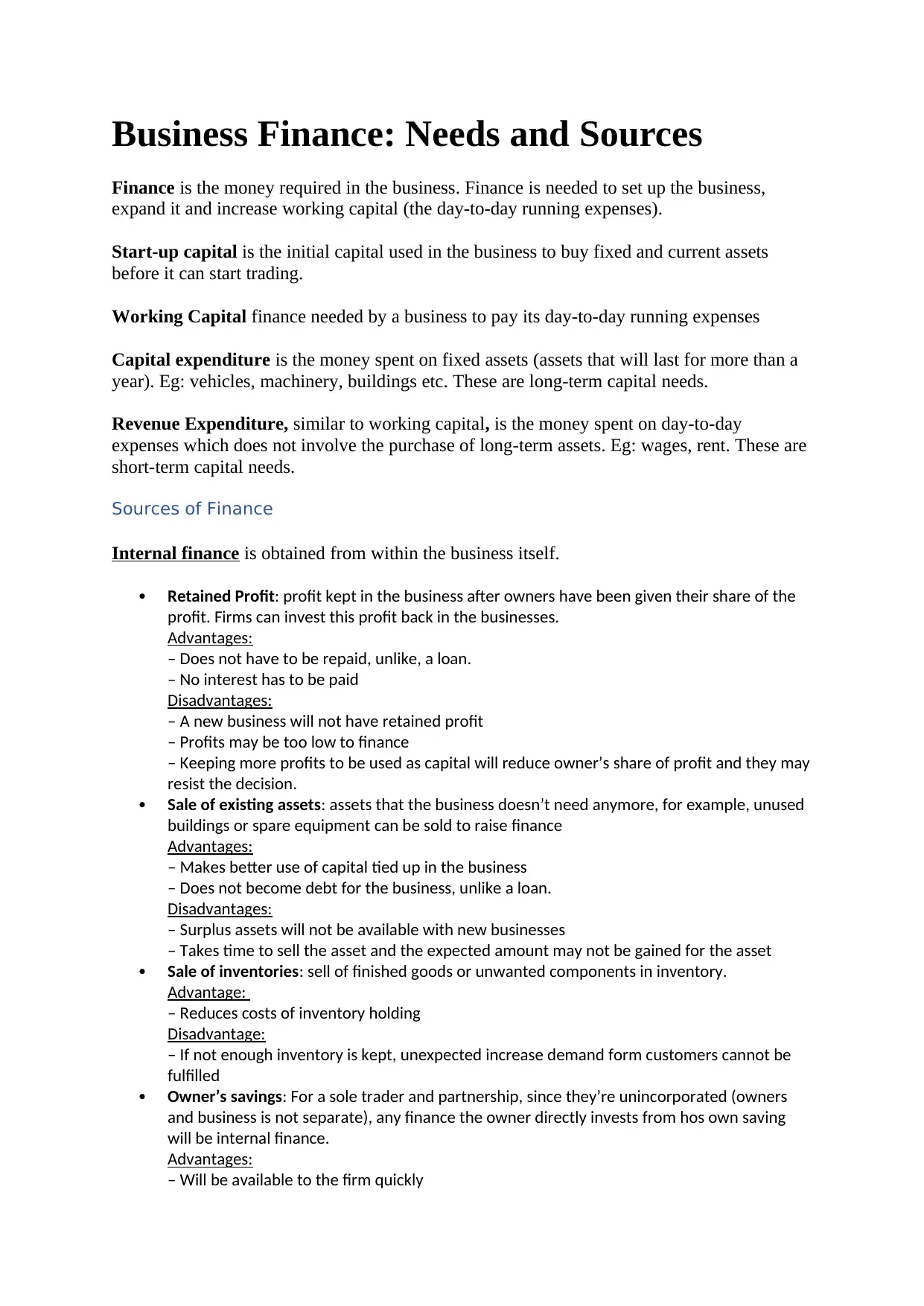
Business Finance: Needs and Sources
Finance is the money required in the business. Finance is needed to set up the business,
expand it and increase working capital (the day-to-day running expenses).
Start-up capital is the initial capital used in the business to buy fixed and current assets
before it can start trading.
Working Capital finance needed by a business to pay its day-to-day running expenses
Capital expenditure is the money spent on fixed assets (assets that will last for more than a
year). Eg: vehicles, machinery, buildings etc. These are long-term capital needs.
Revenue Expenditure, similar to working capital, is the money spent on day-to-day
expenses which does not involve the purchase of long-term assets. Eg: wages, rent. These are
short-term capital needs.
Sources of Finance
Internal finance is obtained from within the business itself.
Retained Profit: profit kept in the business after owners have been given their share of the
profit. Firms can invest this profit back in the businesses.
Advantages:
– Does not have to be repaid, unlike, a loan.
– No interest has to be paid
Disadvantages:
– A new business will not have retained profit
– Profits may be too low to finance
– Keeping more profits to be used as capital will reduce owner’s share of profit and they may
resist the decision.
Sale of existing assets: assets that the business doesn’t need anymore, for example, unused
buildings or spare equipment can be sold to raise finance
Advantages:
– Makes better use of capital tied up in the business
– Does not become debt for the business, unlike a loan.
Disadvantages:
– Surplus assets will not be available with new businesses
– Takes time to sell the asset and the expected amount may not be gained for the asset
Sale of inventories: sell of finished goods or unwanted components in inventory.
Advantage:
– Reduces costs of inventory holding
Disadvantage:
– If not enough inventory is kept, unexpected increase demand form customers cannot be
fulfilled
Owner’s savings: For a sole trader and partnership, since they’re unincorporated (owners
and business is not separate), any finance the owner directly invests from hos own saving
will be internal finance.
Advantages:
– Will be available to the firm quickly
Finance is the money required in the business. Finance is needed to set up the business,
expand it and increase working capital (the day-to-day running expenses).
Start-up capital is the initial capital used in the business to buy fixed and current assets
before it can start trading.
Working Capital finance needed by a business to pay its day-to-day running expenses
Capital expenditure is the money spent on fixed assets (assets that will last for more than a
year). Eg: vehicles, machinery, buildings etc. These are long-term capital needs.
Revenue Expenditure, similar to working capital, is the money spent on day-to-day
expenses which does not involve the purchase of long-term assets. Eg: wages, rent. These are
short-term capital needs.
Sources of Finance
Internal finance is obtained from within the business itself.
Retained Profit: profit kept in the business after owners have been given their share of the
profit. Firms can invest this profit back in the businesses.
Advantages:
– Does not have to be repaid, unlike, a loan.
– No interest has to be paid
Disadvantages:
– A new business will not have retained profit
– Profits may be too low to finance
– Keeping more profits to be used as capital will reduce owner’s share of profit and they may
resist the decision.
Sale of existing assets: assets that the business doesn’t need anymore, for example, unused
buildings or spare equipment can be sold to raise finance
Advantages:
– Makes better use of capital tied up in the business
– Does not become debt for the business, unlike a loan.
Disadvantages:
– Surplus assets will not be available with new businesses
– Takes time to sell the asset and the expected amount may not be gained for the asset
Sale of inventories: sell of finished goods or unwanted components in inventory.
Advantage:
– Reduces costs of inventory holding
Disadvantage:
– If not enough inventory is kept, unexpected increase demand form customers cannot be
fulfilled
Owner’s savings: For a sole trader and partnership, since they’re unincorporated (owners
and business is not separate), any finance the owner directly invests from hos own saving
will be internal finance.
Advantages:
– Will be available to the firm quickly
Paraphrase This Document
Need a fresh take? Get an instant paraphrase of this document with our AI Paraphraser
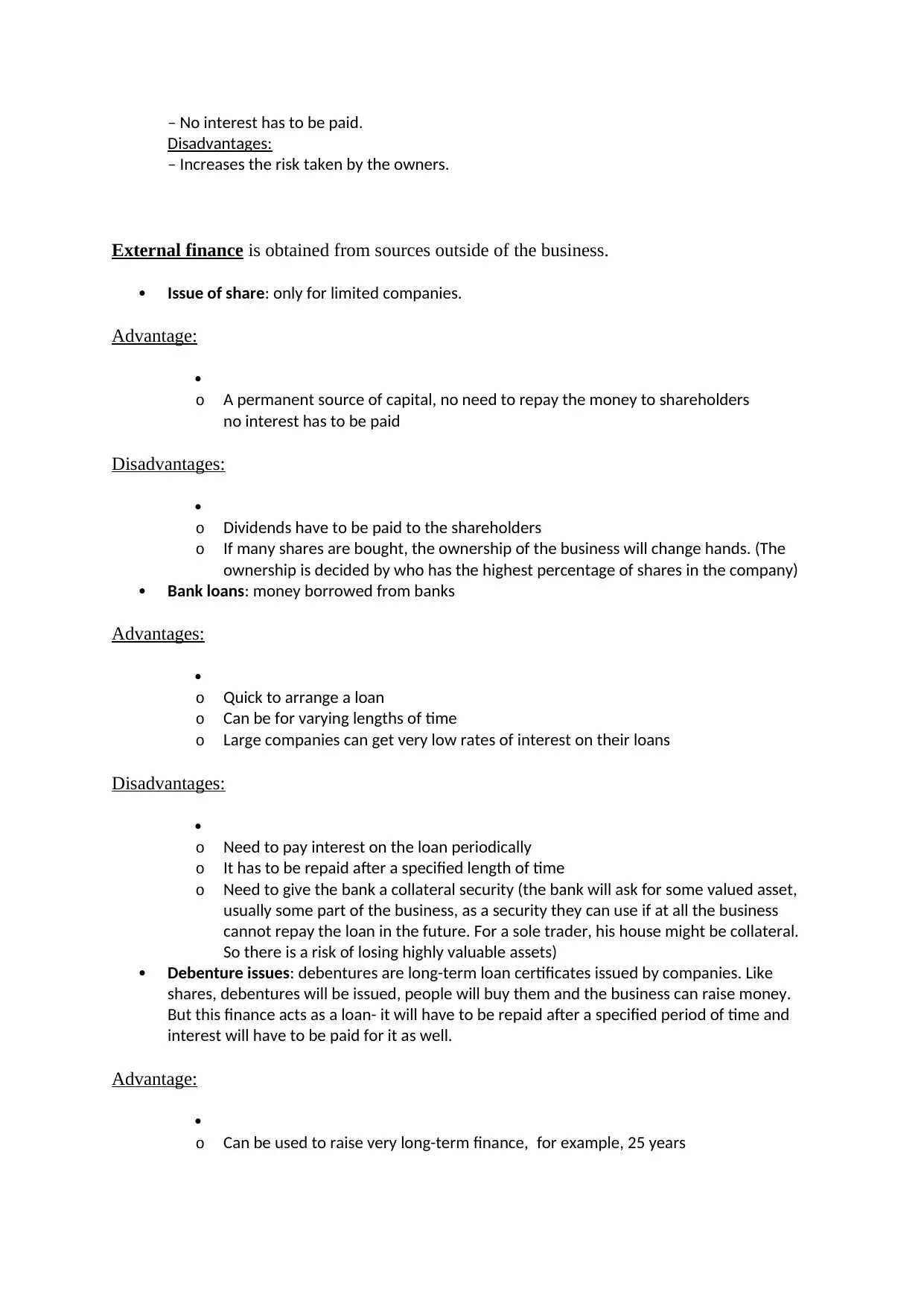
– No interest has to be paid.
Disadvantages:
– Increases the risk taken by the owners.
External finance is obtained from sources outside of the business.
Issue of share: only for limited companies.
Advantage:
o A permanent source of capital, no need to repay the money to shareholders
no interest has to be paid
Disadvantages:
o Dividends have to be paid to the shareholders
o If many shares are bought, the ownership of the business will change hands. (The
ownership is decided by who has the highest percentage of shares in the company)
Bank loans: money borrowed from banks
Advantages:
o Quick to arrange a loan
o Can be for varying lengths of time
o Large companies can get very low rates of interest on their loans
Disadvantages:
o Need to pay interest on the loan periodically
o It has to be repaid after a specified length of time
o Need to give the bank a collateral security (the bank will ask for some valued asset,
usually some part of the business, as a security they can use if at all the business
cannot repay the loan in the future. For a sole trader, his house might be collateral.
So there is a risk of losing highly valuable assets)
Debenture issues: debentures are long-term loan certificates issued by companies. Like
shares, debentures will be issued, people will buy them and the business can raise money.
But this finance acts as a loan- it will have to be repaid after a specified period of time and
interest will have to be paid for it as well.
Advantage:
o Can be used to raise very long-term finance, for example, 25 years
Disadvantages:
– Increases the risk taken by the owners.
External finance is obtained from sources outside of the business.
Issue of share: only for limited companies.
Advantage:
o A permanent source of capital, no need to repay the money to shareholders
no interest has to be paid
Disadvantages:
o Dividends have to be paid to the shareholders
o If many shares are bought, the ownership of the business will change hands. (The
ownership is decided by who has the highest percentage of shares in the company)
Bank loans: money borrowed from banks
Advantages:
o Quick to arrange a loan
o Can be for varying lengths of time
o Large companies can get very low rates of interest on their loans
Disadvantages:
o Need to pay interest on the loan periodically
o It has to be repaid after a specified length of time
o Need to give the bank a collateral security (the bank will ask for some valued asset,
usually some part of the business, as a security they can use if at all the business
cannot repay the loan in the future. For a sole trader, his house might be collateral.
So there is a risk of losing highly valuable assets)
Debenture issues: debentures are long-term loan certificates issued by companies. Like
shares, debentures will be issued, people will buy them and the business can raise money.
But this finance acts as a loan- it will have to be repaid after a specified period of time and
interest will have to be paid for it as well.
Advantage:
o Can be used to raise very long-term finance, for example, 25 years
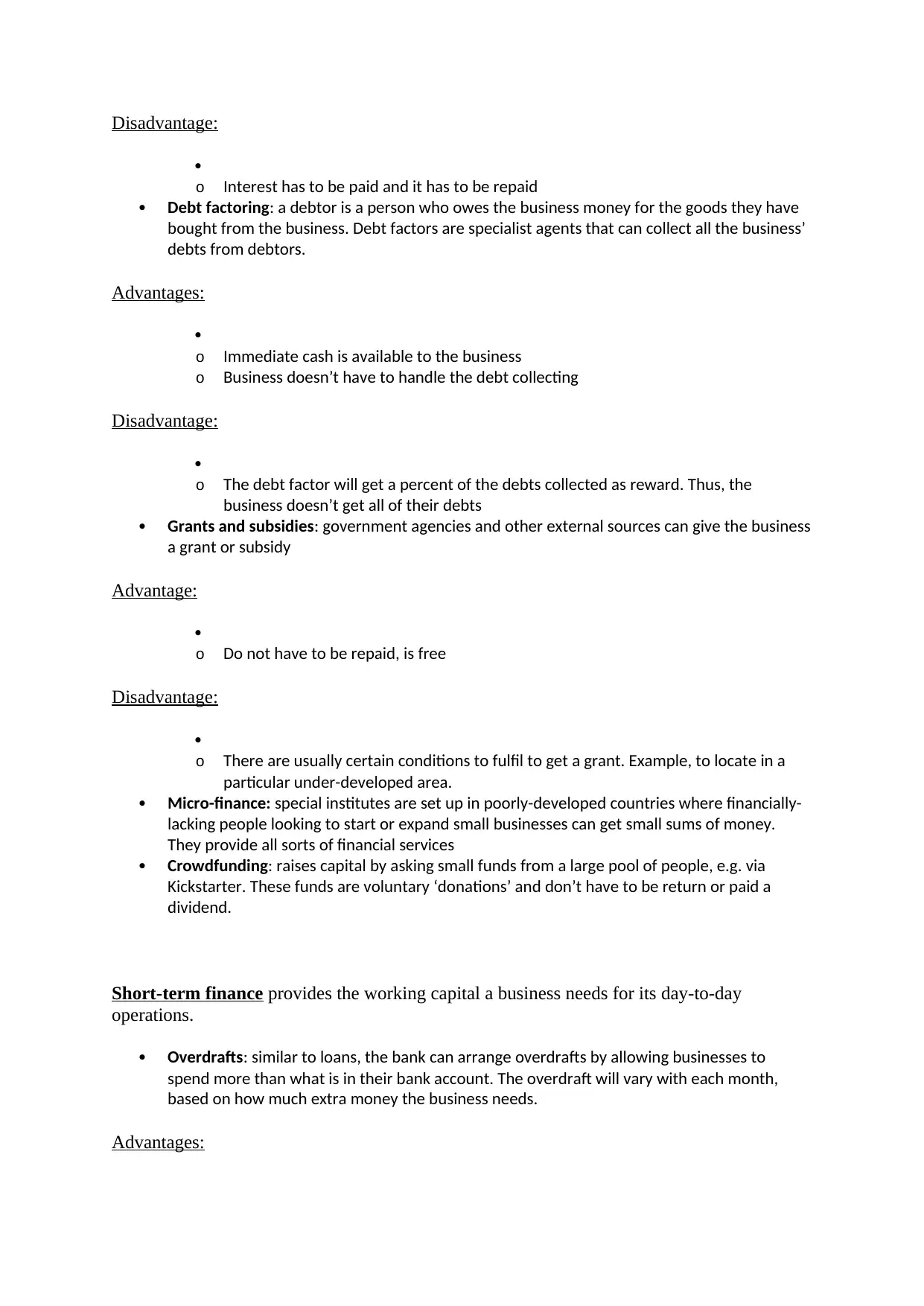
Disadvantage:
o Interest has to be paid and it has to be repaid
Debt factoring: a debtor is a person who owes the business money for the goods they have
bought from the business. Debt factors are specialist agents that can collect all the business’
debts from debtors.
Advantages:
o Immediate cash is available to the business
o Business doesn’t have to handle the debt collecting
Disadvantage:
o The debt factor will get a percent of the debts collected as reward. Thus, the
business doesn’t get all of their debts
Grants and subsidies: government agencies and other external sources can give the business
a grant or subsidy
Advantage:
o Do not have to be repaid, is free
Disadvantage:
o There are usually certain conditions to fulfil to get a grant. Example, to locate in a
particular under-developed area.
Micro-finance: special institutes are set up in poorly-developed countries where financially-
lacking people looking to start or expand small businesses can get small sums of money.
They provide all sorts of financial services
Crowdfunding: raises capital by asking small funds from a large pool of people, e.g. via
Kickstarter. These funds are voluntary ‘donations’ and don’t have to be return or paid a
dividend.
Short-term finance provides the working capital a business needs for its day-to-day
operations.
Overdrafts: similar to loans, the bank can arrange overdrafts by allowing businesses to
spend more than what is in their bank account. The overdraft will vary with each month,
based on how much extra money the business needs.
Advantages:
o Interest has to be paid and it has to be repaid
Debt factoring: a debtor is a person who owes the business money for the goods they have
bought from the business. Debt factors are specialist agents that can collect all the business’
debts from debtors.
Advantages:
o Immediate cash is available to the business
o Business doesn’t have to handle the debt collecting
Disadvantage:
o The debt factor will get a percent of the debts collected as reward. Thus, the
business doesn’t get all of their debts
Grants and subsidies: government agencies and other external sources can give the business
a grant or subsidy
Advantage:
o Do not have to be repaid, is free
Disadvantage:
o There are usually certain conditions to fulfil to get a grant. Example, to locate in a
particular under-developed area.
Micro-finance: special institutes are set up in poorly-developed countries where financially-
lacking people looking to start or expand small businesses can get small sums of money.
They provide all sorts of financial services
Crowdfunding: raises capital by asking small funds from a large pool of people, e.g. via
Kickstarter. These funds are voluntary ‘donations’ and don’t have to be return or paid a
dividend.
Short-term finance provides the working capital a business needs for its day-to-day
operations.
Overdrafts: similar to loans, the bank can arrange overdrafts by allowing businesses to
spend more than what is in their bank account. The overdraft will vary with each month,
based on how much extra money the business needs.
Advantages:
⊘ This is a preview!⊘
Do you want full access?
Subscribe today to unlock all pages.

Trusted by 1+ million students worldwide
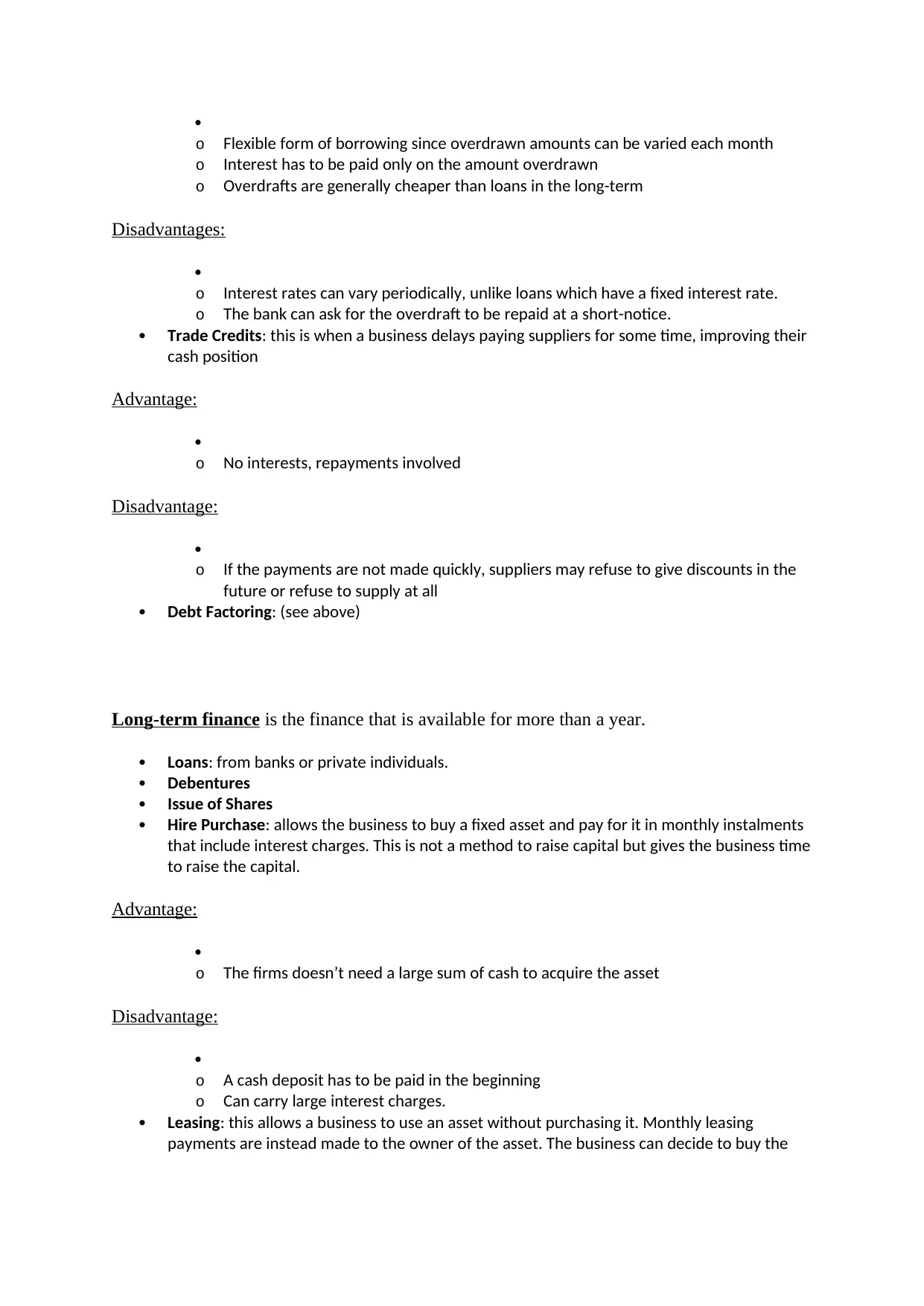
o Flexible form of borrowing since overdrawn amounts can be varied each month
o Interest has to be paid only on the amount overdrawn
o Overdrafts are generally cheaper than loans in the long-term
Disadvantages:
o Interest rates can vary periodically, unlike loans which have a fixed interest rate.
o The bank can ask for the overdraft to be repaid at a short-notice.
Trade Credits: this is when a business delays paying suppliers for some time, improving their
cash position
Advantage:
o No interests, repayments involved
Disadvantage:
o If the payments are not made quickly, suppliers may refuse to give discounts in the
future or refuse to supply at all
Debt Factoring: (see above)
Long-term finance is the finance that is available for more than a year.
Loans: from banks or private individuals.
Debentures
Issue of Shares
Hire Purchase: allows the business to buy a fixed asset and pay for it in monthly instalments
that include interest charges. This is not a method to raise capital but gives the business time
to raise the capital.
Advantage:
o The firms doesn’t need a large sum of cash to acquire the asset
Disadvantage:
o A cash deposit has to be paid in the beginning
o Can carry large interest charges.
Leasing: this allows a business to use an asset without purchasing it. Monthly leasing
payments are instead made to the owner of the asset. The business can decide to buy the
o Flexible form of borrowing since overdrawn amounts can be varied each month
o Interest has to be paid only on the amount overdrawn
o Overdrafts are generally cheaper than loans in the long-term
Disadvantages:
o Interest rates can vary periodically, unlike loans which have a fixed interest rate.
o The bank can ask for the overdraft to be repaid at a short-notice.
Trade Credits: this is when a business delays paying suppliers for some time, improving their
cash position
Advantage:
o No interests, repayments involved
Disadvantage:
o If the payments are not made quickly, suppliers may refuse to give discounts in the
future or refuse to supply at all
Debt Factoring: (see above)
Long-term finance is the finance that is available for more than a year.
Loans: from banks or private individuals.
Debentures
Issue of Shares
Hire Purchase: allows the business to buy a fixed asset and pay for it in monthly instalments
that include interest charges. This is not a method to raise capital but gives the business time
to raise the capital.
Advantage:
o The firms doesn’t need a large sum of cash to acquire the asset
Disadvantage:
o A cash deposit has to be paid in the beginning
o Can carry large interest charges.
Leasing: this allows a business to use an asset without purchasing it. Monthly leasing
payments are instead made to the owner of the asset. The business can decide to buy the
Paraphrase This Document
Need a fresh take? Get an instant paraphrase of this document with our AI Paraphraser
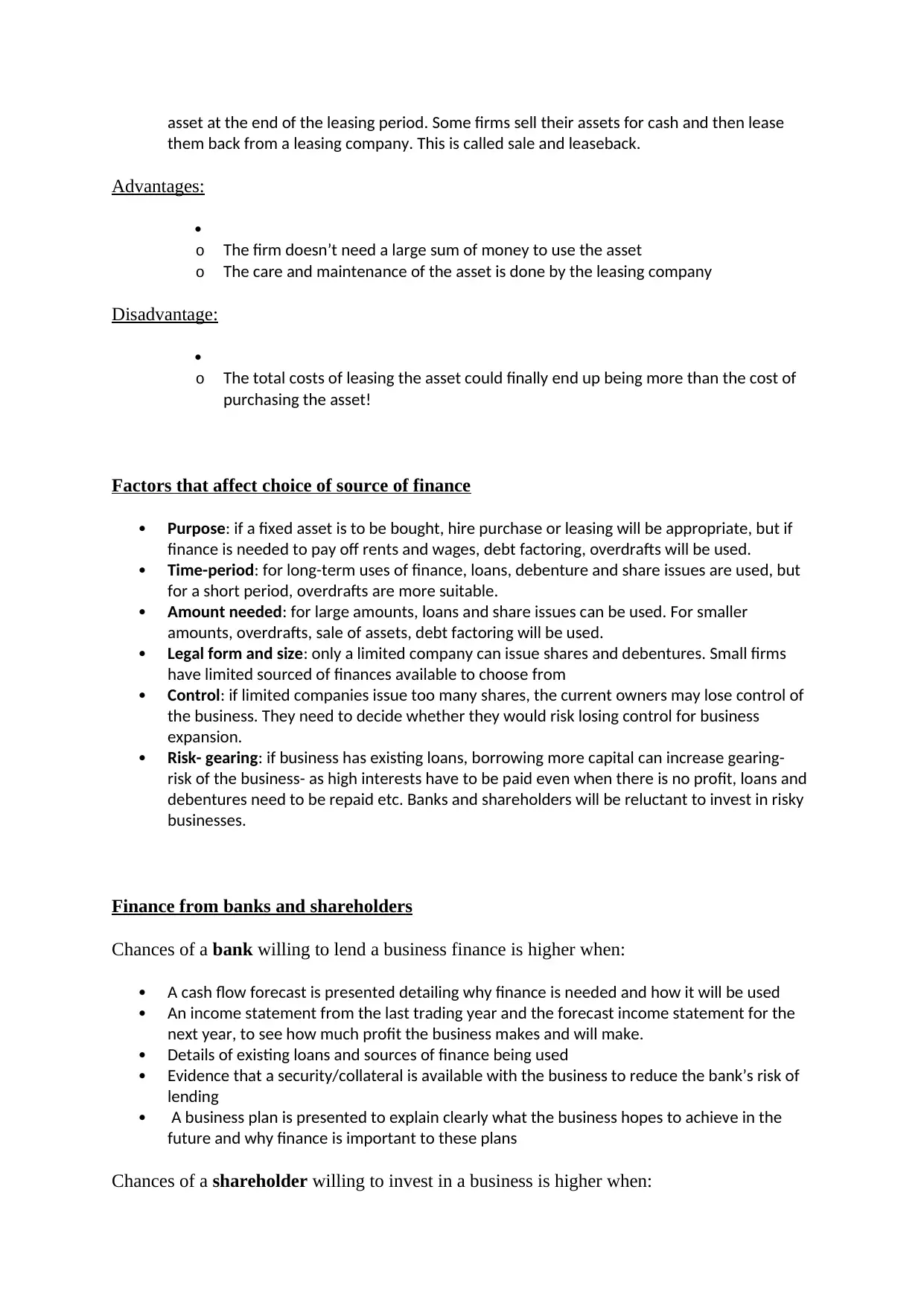
asset at the end of the leasing period. Some firms sell their assets for cash and then lease
them back from a leasing company. This is called sale and leaseback.
Advantages:
o The firm doesn’t need a large sum of money to use the asset
o The care and maintenance of the asset is done by the leasing company
Disadvantage:
o The total costs of leasing the asset could finally end up being more than the cost of
purchasing the asset!
Factors that affect choice of source of finance
Purpose: if a fixed asset is to be bought, hire purchase or leasing will be appropriate, but if
finance is needed to pay off rents and wages, debt factoring, overdrafts will be used.
Time-period: for long-term uses of finance, loans, debenture and share issues are used, but
for a short period, overdrafts are more suitable.
Amount needed: for large amounts, loans and share issues can be used. For smaller
amounts, overdrafts, sale of assets, debt factoring will be used.
Legal form and size: only a limited company can issue shares and debentures. Small firms
have limited sourced of finances available to choose from
Control: if limited companies issue too many shares, the current owners may lose control of
the business. They need to decide whether they would risk losing control for business
expansion.
Risk- gearing: if business has existing loans, borrowing more capital can increase gearing-
risk of the business- as high interests have to be paid even when there is no profit, loans and
debentures need to be repaid etc. Banks and shareholders will be reluctant to invest in risky
businesses.
Finance from banks and shareholders
Chances of a bank willing to lend a business finance is higher when:
A cash flow forecast is presented detailing why finance is needed and how it will be used
An income statement from the last trading year and the forecast income statement for the
next year, to see how much profit the business makes and will make.
Details of existing loans and sources of finance being used
Evidence that a security/collateral is available with the business to reduce the bank’s risk of
lending
A business plan is presented to explain clearly what the business hopes to achieve in the
future and why finance is important to these plans
Chances of a shareholder willing to invest in a business is higher when:
them back from a leasing company. This is called sale and leaseback.
Advantages:
o The firm doesn’t need a large sum of money to use the asset
o The care and maintenance of the asset is done by the leasing company
Disadvantage:
o The total costs of leasing the asset could finally end up being more than the cost of
purchasing the asset!
Factors that affect choice of source of finance
Purpose: if a fixed asset is to be bought, hire purchase or leasing will be appropriate, but if
finance is needed to pay off rents and wages, debt factoring, overdrafts will be used.
Time-period: for long-term uses of finance, loans, debenture and share issues are used, but
for a short period, overdrafts are more suitable.
Amount needed: for large amounts, loans and share issues can be used. For smaller
amounts, overdrafts, sale of assets, debt factoring will be used.
Legal form and size: only a limited company can issue shares and debentures. Small firms
have limited sourced of finances available to choose from
Control: if limited companies issue too many shares, the current owners may lose control of
the business. They need to decide whether they would risk losing control for business
expansion.
Risk- gearing: if business has existing loans, borrowing more capital can increase gearing-
risk of the business- as high interests have to be paid even when there is no profit, loans and
debentures need to be repaid etc. Banks and shareholders will be reluctant to invest in risky
businesses.
Finance from banks and shareholders
Chances of a bank willing to lend a business finance is higher when:
A cash flow forecast is presented detailing why finance is needed and how it will be used
An income statement from the last trading year and the forecast income statement for the
next year, to see how much profit the business makes and will make.
Details of existing loans and sources of finance being used
Evidence that a security/collateral is available with the business to reduce the bank’s risk of
lending
A business plan is presented to explain clearly what the business hopes to achieve in the
future and why finance is important to these plans
Chances of a shareholder willing to invest in a business is higher when:
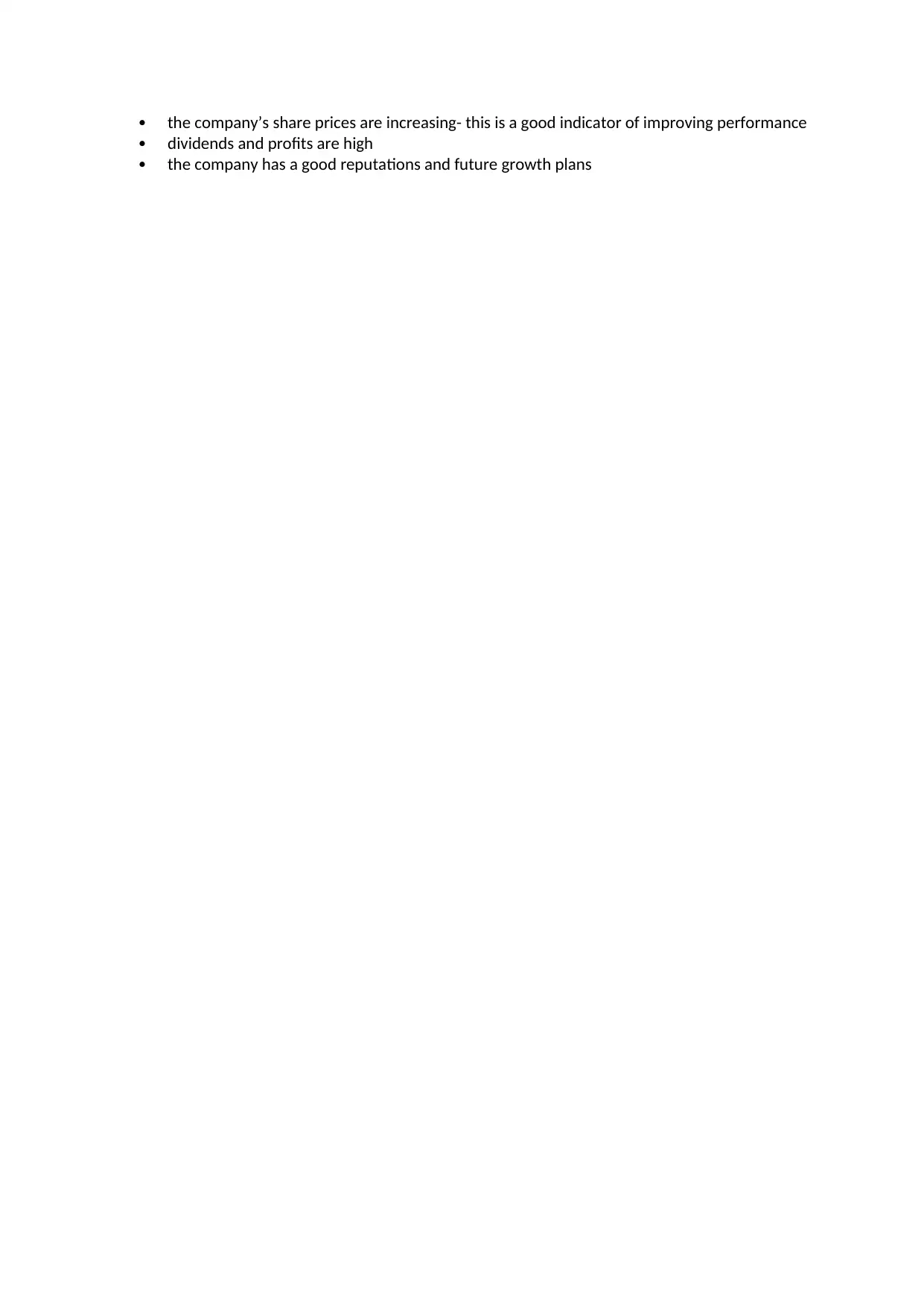
the company’s share prices are increasing- this is a good indicator of improving performance
dividends and profits are high
the company has a good reputations and future growth plans
dividends and profits are high
the company has a good reputations and future growth plans
⊘ This is a preview!⊘
Do you want full access?
Subscribe today to unlock all pages.

Trusted by 1+ million students worldwide
1 out of 6
Related Documents
Your All-in-One AI-Powered Toolkit for Academic Success.
+13062052269
info@desklib.com
Available 24*7 on WhatsApp / Email
![[object Object]](/_next/static/media/star-bottom.7253800d.svg)
Unlock your academic potential
Copyright © 2020–2025 A2Z Services. All Rights Reserved. Developed and managed by ZUCOL.





